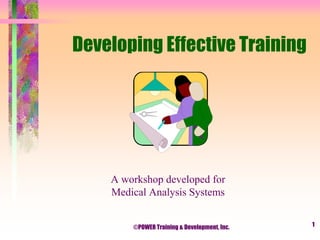
Dev Effec Trng Wrkshp
- 1. Developing Effective Training A workshop developed for Medical Analysis Systems ©POWER Training & Development, Inc. 1
- 2. Four Basic Assumptions • Need to be self-directed • Possess a reservoir of experience • Possess a “Readiness” for learning • Prefer a problem centered approach vs subject centered ©POWER Training & Development, Inc. 2
- 3. Active vs Passive Learning Studies indicate after 3 days, we remember: • 10% of what we read • 20% of what we hear • 30% of what we see • 50% of what we see and hear • 70% of what we say • 90% of what we say and do ©POWER Training & Development, Inc. 3
- 4. I hear, I forget I see, I remember I do, I understand ©POWER Training & Development, Inc. 4
- 5. Analyzing the Training Requirement 5
- 6. Establishing Learning Objectives • Enables specific results: – provides learner with skills and knowledge – provides learner with expectations ©POWER Training & Development, Inc. 6
- 7. Criteria for Objectives • Performance – the desired outcome (product or results) • Conditions – conditions of performance • Criterion – what is acceptable performance (time limit, accuracy or quality measurement) ©POWER Training & Development, Inc. 7
- 8. Outlining Training Content • List actions • Identify knowledge required • Sequence the training content ©POWER Training & Development, Inc. 8
- 9. R-O-P-E-S Methodology • Review • Overview • Presentation • Exercise • Summary ©POWER Training & Development, Inc. 9
- 10. Instructional Methods • Lecture • Discussion • Demonstration • Case/Study • Role Play/Skill Practice • Games ©POWER Training & Development, Inc. 10
- 11. Lecture Advantages Disadvantages • Keeps group • Can be dull together • Difficult to gauge • Time control attention of group easier • Retention is • Good for large limited group (20+) ©POWER Training & Development, Inc. 11
- 12. Discussion Advantages Disadvantages • Keeps learners • Learning points interested/involved can be confusing • Learner resources or lost discovered/shared • A few learner may • Learning can be dominate observed • Time control is more difficult ©POWER Training & Development, Inc. 12
- 13. Demonstration Advantages Disadvantages • Keeps learners • Demonstrator interested/involved needs to be • Learners can see expert the “model” • May require • Aids retention logistic challenge • Learning can be observed ©POWER Training & Development, Inc. 13
- 14. Case Study Advantages Disadvantages • Requires active • Information must learner involvement be precise and • Can stimulate up-to-date performance • Can take time required after trng. • Learners become • Learning can be too interested in observed case content ©POWER Training & Development, Inc. 14
- 15. Role Play/Skill Practice Advantages Disadvantages • Aids retention • Requires preparation • Allows practice of time new skill in • Difficult to tailor to all controlled learner situations environment • Requires lots of time • Learners actively involved ©POWER Training & Development, Inc. 15
- 16. Games Advantages Disadvantages • Fun! • Requires preparation • Learners actively time involved • Can be considered • Learning can be “dumb” observed • May be difficult to tailor to all learners’ situations. ©POWER Training & Development, Inc. 16
- 17. Using Visuals Promote quality of communication > use both sight and sound > aids better retention > reduces mis-communication ©POWER Training & Development, Inc. 17
- 18. Using Visuals Improves learning – reinforces the information from each channel – focuses learners attention – helps trainees interpret and process info – clarifies the message ©POWER Training & Development, Inc. 18
- 19. Types of Visuals • Transparencies • Flipcharts • Printed Materials (hand-outs, job aids) • Videos/films • Mock up or models ©POWER Training & Development, Inc. 19
- 20. Criteria for Visuals • K-I-S-S • Use lots of white space • Use 6-7 words per line • Use no more than 5 lines per visual • Use large letters to be seen by last row ©POWER Training & Development, Inc. 20
- 21. Use of Color Visuals • Accelerates learning, retention, recall 55-78% • Improves and increases comprehension 73% • Increases willingness to read 80% • Sells products and ideas more effectively 50-85% ©POWER Training & Development, Inc. 21
- 22. Evaluating Training • Level 1 - Reaction • Level 2 - Learning • Level 3 - Behavior • Level 4 - Results ©POWER Training & Development, Inc. 22